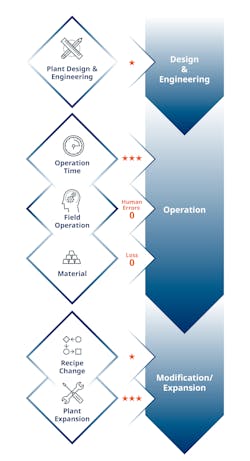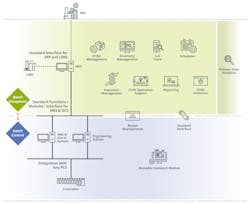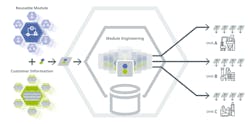Digital tools help batch manufacturers produce new and established products
One concept that has changed all phases of manufacturing is mass customization. Over many years, customers have come to expect more choice across every imaginable range of products, and they expect this choice without either a small or no increase in price. Standardization is a thing of the past because buyers insist on a wide selection, which means manufacturers must find new ways to control costs and remain profitable, while making more product variations in smaller batches. This challenge to resolve two seemingly mutually exclusive goals affects all aspects of manufacturing. For this article, we will focus on a few key industries.
Process manufacturers face this reality every day whether they are making paint, vitamin pills or beer. The common element here is batch manufacturing, which is the main production technique of specialty chemicals, pharmaceuticals, food and beverage, and similar industries. The nature of batch manufacturing makes it more adaptable to highly customized products when compared to something hugely scale-dependent, like oil refining or commodity chemical production, but only if appropriate management tools and methods are selected and applied well.
How does mass customization affect batch manufacturing?
- Product changes and new introductions must happen more frequently to follow trends in consumer demand.
- Product development cycle times must be compressed to deliver products while demand is greatest.
- Designers must interpret changing demand and translate their conclusions into producible attributes to make products match demand.
- Manufacturers frequently find themselves in unexplored territory since they may be called upon to try new approaches and untested processing techniques.
How then do these changes affect batch manufacturing techniques directly? The most obvious change is a given facility must manufacture a wider range of products, instead of the same tried-and-true products again and again. This has several direct consequences.
- Validating new recipe and manufacturing procedures requires more time since new cycles happen frequently.
- Manufacturing hardware must be reconfigured frequently, introducing opportunities for errors and damage.
- Individual recipes are produced less frequently, so there is little opportunity for operators to settle into a useful routine, allowing errors associated with manual operations to creep in.
- Variability between batches increases because it is difficult to identify the critical variables that need to be closely controlled to ensure consistent product quality when the same operation is run less frequently.
- Production data may be available, but it is difficult to utilize for improving processes.
The challenges related to batch manufacturing in this context are unavoidable, but there are effective ways to solve or at least minimize each of them. A critical element is integration between the process control system and the manufacturing execution system, as detailed below.
Avoiding and mitigating problems
Batch manufacturing depends on two main platforms: a process control system (PCS) and a manufacturing execution system (MES). For some companies, these two systems operate in parallel, totally isolated from each other. Where this is the case, both sides also depend on many manual procedures to perform functions that would be done automatically if the systems were integrated more completely.
On the other hand, for some companies, both the PCS and MES functions are performed by one system, eliminating this separation. This reduces the potential for human error by addressing automated and manual operational issues simultaneously.
Such an all-encompassing system must be designed specifically for batch manufacturers, and it can cover the entire manufacturing process from end to end. Let’s think for a moment of the functional areas included when integrating a PCS and MES (Figure 1).
The very first step is plant design and engineering. This may be after the fact for an existing facility, but the same concepts apply whether upgrading or adding a new production unit. Integration of the PCS and MES provides an intuitive design environment with paperless engineering methods able to access data from earlier projects, so important know-how can be easily accessed and reused to cut costs and shorten design time. New processes can be validated to move into the production phase without delays to get new products into the supply network more quickly.
Once in operation, batch manufacturing functions come into full force following procedures. Accurately managing the time required to execute procedures in the PCS and MES increases productivity. The automated elements of the process can be optimized, while integrating field operations, such as adding a small amount of a minor ingredient partway through a mixing and reaction cycle. Accurate inventory management and procedures will bring material loss closer to zero.
These types of information must be verified and entered into the batch report for immediate and future reference, providing full traceability for the batch now and for future analysis. If there are problems or an especially high degree of success, it is possible to determine the root cause for either case through statistical analysis.
If a recipe needs modification to adjust an existing product or create a new one, the engineering work is reduced by taking advantage of reusable modules. The same approach applies to equipment modifications capable of streamlining production.
Blending PCS and MES
The MES controlling a facility oversees production scheduling, dispatching, recipe management, field operations support and electronic batch recording. It connects with higher-level corporate networks and enterprise resource planning (ERP) functions (Figure 2).
MES handles all the support functions outside of direct manufacturing, including statistical analysis of production operations. It also interfaces with other systems, such as the laboratory information management system where research and development initiatives usually originate. Some MES functions relate specifically to the individual production unit, while others may cover multiple units. Even if there is a higher-level MES, it is better to have the immediate MES functions for the unit performed at the unit using techniques adapted specifically for batch manufacturing.
The PCS oversees actual manufacturing functions, but recipe management extends into both areas since recipe modifications can originate from either side.
Any platform supporting a batch manufacturing environment must be aligned with two critical manufacturing standards. The first is ISA95, Enterprise-Control System Integration standard. It defines the interface between control functions and other enterprise functions. Most of the standard deals with the interaction between levels 3 and 4 of the Purdue Reference Model.
The second is ISA88, Batch Control standard. It offers guidance for design and specifications of batch control systems. The two standards, working together, cover both batch management and batch control, eliminating any gaps.
The system supporting a batch manufacturing environment must provide a procedural control model of overall procedures, unit procedures, operations and phases. It should be managed in an integrated engineering environment with recipe creation.
The system works together with the physical model of units, equipment modules and control modules — each of which is designed in an engineering environment compatible with the PCS. Reusable modules for contents of procedural control models and physical models are available for efficient implementation.
New process improves operations
Since much of the challenge for batch manufacturers today relates to mass customization, let’s follow how the new product design process works using modern tools.
Traditionally, designers working on new products concentrate on the process itself, followed by process control methods and then eventually MES considerations. This tends to stretch out the timeline, while creating multiple opportunities for human error to creep into the process. The PCS side may have to go through multiple iterations to ensure consistent product quality and effective execution management. Over time, the necessary documentation can be accumulated. This approach works, but it is not very fast nor predictable.
An integrated batch solution compresses the design process by building on a combination of modules that have accumulated past know-how and experience. Standard design modules minimize development effort, while maintaining engineering quality for batch process design and recipe creation (Figure 3).
These modules capture know-how and can be modified and used multiple times; therefore, far less must be created from scratch. Engineers can design applications and check their functionality without having to write new programs. These capabilities make it easier to create documents related to user requirement and functional design specifications.
MES design also uses templates for typical functions, shortening design and implementation.
Once production has started, the focus shifts to emphasize execution, ensuring product quality while keeping costs and delivery schedules in line. A major element of this is avoiding problems resulting from human error by using three tools:
- Standard operating procedure (SOP) management details all operations to ensure defined actions are performed correctly and documented.
- Condition displays show the four main production elements: human operator, equipment assets, raw materials and production method.
- Field operation navigation and barcode identification confirms manual operations.
Batch reporting must include both automated PCS operations and manual steps. The right platform integrates these into one report to accompany the current batch, and it historizes all data for later analysis.
Over time, this data helps raise production quality by improving PCS operations and field operations though the analysis of operational data. The system identifies and monitors critical process parameters, comparing production batches against golden-batch baselines. This creates a process of continuous improvement where operational data is analyzed, with the results of the analysis used to improve operations.
Clear system instructions for field operators improve a manager’s ability to assign a manufacturing process to more potential individuals without depending on specialized and often undocumented know-how retained by key people. Even if an operator makes a mistake, the system will call out the problem and provide instructions on how it can be corrected before proceeding to the next step. This methodology ensures knowledge is captured and kept for future use as plant personnel change over.
Yokogawa provides batch control and management systems, data analytics solutions and services to improve production quality. Using batch manufacturers’ process data, operational data and process knowledge, it is possible to leverage strengths in analytics, measurement and control in a collaborative approach to identify problems and create action plans to improve quality and productivity, whatever the market conditions.
Masanori Narukawa is part of the system products sales promotion staff with Yokogawa Electric Corporation. He joined Yokogawa in 1998 and worked as a software engineer for integrated control system for more than 15 years, and he is now in charge of digital content for the marketing of industrial automation system products. Narukawa holds a degree in information technology from the Kanazawa Institute of Technology.
Kazue Sato is a sales engineer for the chemical industry with Yokogawa Electric Corporation. Since joining Yokogawa in 2013, she has worked in global sales and marketing of Yokogawa products and solutions mainly for chemical customers. She also has project execution experience for batch processes gained during her time as an application engineer in the U.S. during 2019. Sato holds a Master of Science degree from Tokyo University of Science.
Yokogawa Electric Corporation
About the Author
Masanori Narukawa
Masanori Narukawa is part of the system products sales promotion staff with Yokogawa Electric Corporation. He joined Yokogawa in 1998 and worked as a software engineer for integrated control system for more than 15 years, and he is now in charge of digital content for the marketing of industrial automation system products. Narukawa holds a degree in information technology from the Kanazawa Institute of Technology.
Kazue Sato
Kazue Sato is a sales engineer for the chemical industry with Yokogawa Electric Corporation. Since joining Yokogawa in 2013, she has worked in global sales and marketing of Yokogawa products and solutions mainly for chemical customers. She also has project execution experience for batch processes gained during her time as an application engineer in the U.S. during 2019. Sato holds a Master of Science degree from Tokyo University of Science.



